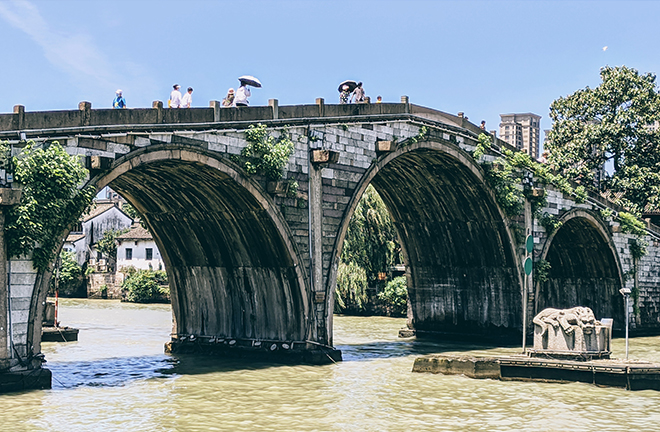Canal aesthetics in the context of Chinese civilization

The Beijing-Hangzhou Grand Canal Photo: Tuchong
The development of civilization hinges on a myriad of specific conditions and factors that interact to drive society forward, and rivers are one of them. They have played an important role in the formation of human civilization, providing necessary survival resources for early humans and subsequently driving societal progress. Canals emerged initially to meet the agricultural irrigation needs of ancient society, facilitating transportation and trade, supporting urban construction and population growth, and promoting the development of smelting and industry. These demands and developments have led to the construction of canal systems, making them a vital component in the development of Chinese civilization. Canals exhibit rich aesthetic characteristics. The aesthetic interpretation of canals is not only an appreciation of natural landscapes, but also an appreciation and analysis of the integration of political, economic, historical, and cultural activities. This aesthetic interpretation is a resonance and fusion of humanity and nature, humanity and history, and humanity and culture.
Aesthetic interpretation
The natural beauty of canal culture has taken on different forms in ancient and modern times. Unlike natural rivers, canals are manually constructed waterway systems connecting different watersheds for transportation. They include facilities such as manually excavated river courses, channels, waterways, locks, and sluices, as well as surface or subterranean pipeline systems. The practice of manual river excavation dates back to the Shang dynasty (c. 16th century–11th century BCE), initially serving irrigation and water conservancy purposes. As society developed, canals not only facilitated farmland irrigation but also became important channels for goods transportation and cultural communication. Particularly during the Sui (581-618) and Tang (618-907) dynasties, the construction of the Grand Canal addressed the scarcity of north-south rivers, enabling the exchange of resources and culture between the northern and southern regions.
The symbolic beauty of canal culture is now reflected in material, intellectual, and cultural dimensions. From a material perspective, ancient canals promoted material exchange and trade activities, while in modern times, they have played an important role in urban planning. In relevant areas, canals have been preserved and repurposed as cultural landscapes, providing urban green leisure spaces. From an intellectual perspective, the excavation of canals by primitive manpower aimed to overcome the limitations of natural water systems. Culturally, canals serve as conduits for the history, traditional customs, and religious beliefs of different regions, bestowing historical and cultural heritage upon the places they traverse. They symbolize the inheritance of ancient wisdom, cultural traditions, and civilization, embodying the peace and prosperity of the country.
Sci-tech presentation
In light of the current development of canals, various local governments have made every effort to construct and preserve these waterways. They have taken steps to incorporate the historical and cultural significance of canals into museums, providing a window for the public to learn more about their history. Leading this effort is the digital design of the China Grand Canal Museum in Yangzhou, where the “Boats on the Canal” exhibition combines physical and multimedia virtual experiences to narrate the evolution of canal vessels, impart knowledge about various types of boats, and share related stories. This presentation showcases the impact of the cultural integration between the north and south since the opening of the Grand Canal.
The representation of aesthetic economy in canal construction focuses on heritage resources and the ecological environment. By emphasizing aesthetic experience, visual appeal, and social value, the aesthetic transformation aims to drive economic development in the canal area and surrounding cities. Linking canal heritage with the aesthetic economy is to organically combine the canal itself with the historical sites, artistic buildings, creative activities, folk culture, and local lifestyles along the banks, creating a canal tourism landscape with aesthetic value.
From the perspective of canal ecological governance, the main focus is to protect the canal waterway, water quality, and nearby bank slopes, embankments, etc., in order to create a good environment through scientific governance, and to transform ecological aesthetics into economic prosperity.
The aesthetic appeal of canals within the context of Chinese civilization transcends mere beauty; it embodies an intellectual pursuit. As this waterway traverses into the present day, serving as a vessel of our culture, it offers insight into the efforts of past generations in water conservancy projects, architectural artistry, and cultural inheritance.
Xie Wei is a professor from the School of Art and Design at Yangzhou University. Geng Qiyang is an associate research fellow from the Institute of Folk Art at Yangzhou University.
Edited by ZHAO YUAN
